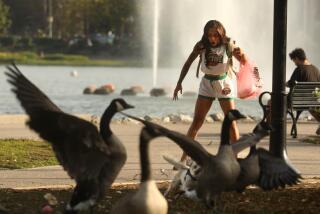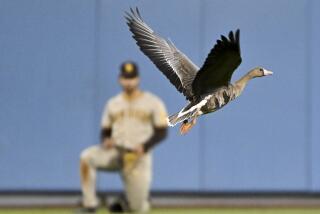Festival Takes a Gander at the Geese in Canada
- Share via
MONTMAGNY, Canada — To be called a perfect goose might be considered mildly insulting in some places, but not in Montmagny, Quebec. In this town along the southern shore of the St. Lawrence River, it is an honor to be the Big Goose.
Actually, there are two Big Geese here, Pampan and Pampinot, who act as mascots for the annual 10-day Festival de L’Oie Blanche, the fall festival of the white geese. Half a dozen citizens take turns dressing up in the two seven-foot goose costumes. It is hot and sweaty inside the costumes (goose down being what it is), but worth it for the esteem of being chosen.
During 10 days (Oct. 16-26 this year) of organized homage to the snow goose, everything takes place from boot hockey (ice, but no skates) to square dancing; boccie ball to soapbox racing; badminton tournaments to wagon rides; polka bands to kayak racing on the St. Lawrence.
All that along with horse-drawn carriage rides, folk singing, a horse-pulling contest, assorted games, handicraft classes and exhibitions, and an event called “Let Go Day” when 100 tons of sand gets dumped into an arena for a giant indoor beach party.
Rowdy, Down-Home Fun
The festival, which began in 1971 when a scant 3,000 geese stopped off (today the total is closer to 125,000), is noisy and gay and rowdy in the relaxed, friendly down-home French-Canadian way. People come mostly from Quebec Province and a few from Maine, according to Michel Mercier, president of the goose festival. “About three in the morning,” he said, “they start to dance on the tables.”
For 10 days every meal served in a big arena at long wooden tables with benches specializes in cuisine of the goose: fried goose, roasted goose, hot goose sandwich, traditional goose pie. I am a little put off by that; I have come to honor geese, not to devour them.
During all this, oblivious to their monopolization of the menu, about 20,000 or so honking honorees are down by the river, protected in a sanctuary. They glide down in gaggles of 300 to 400 in tight V formation, settle into the marshy grass for a day or so, and then flap off noisily for New Jersey, Maryland and other points south. You can hear them honking all over this small French-Canadian town of 13,000, where only about 50 people speak English.
Last fall when my husband and I could get $1.40 Canadian for our American dollar, an airline offered a $250 round-trip fare from Los Angeles to Toronto. Only one catch: We had to travel after Oct. 1.
Changing Colors
I considered that a plus, being a foliage freak. In October I could gawk at all those Canadian leaves changing colors. After all, a country whose national flag sports a maple leaf must have some magnificent fall color.
I am also, I confess, a goose freak. I love them, not to eat, but to gaze upon--their beguiling pomp and self-importance as they waddle about their business on the ground; their grace and precision in flight.
I learned of another snow goose sanctuary on the northern shore of the St. Lawrence, the Cap Tourmente National Wildlife Area where a couple of hundred thousand geese also stop off on their migratory journey. I figured we might as well mosey on up there.
The good news: It’s off-season and prices are reduced; the tourist crowds are gone; rooms are plentiful; the weather is spectacular, crisp Indian summer, and the sycamores, willows, maples, beech, oak, birch and dogwood are still flamboyant orange, canary yellow, rust, amber, gold and burgundy.
Montreal and Quebec City are major cosmopolitan centers but the surrounding towns and villages start to hunker down for winter at the end of September.
No Trendy Boutiques
We didn’t find any commercially quaint villages as in New England: no trendy boutiques, no fern-filled theme restaurants, no over-priced antique stores, no horse-drawn carriages or Stanley Steamer wagons for hire.
The area is primarily rural. Restaurants are pretty much mom-and-pop style and most are closed Sundays. So are the stores and gas stations. The cuisine resembles farm-style Kansan more than the Country French I had expected. This is meat, potatoes and white bread country.
We enjoyed driving country back roads and gawking at picture post card scenes rolling by. Stone churches with towering spires date to the 18th Century by the side of the road; century-old houses with brilliant red roofs, some with elaborately crafted bird houses in their front yards; colorful aqua, yellow and purple painted barns with portraits of prize dairy cows proudly displayed on their sides; small white farmhouses between soft rolling green hills. And a never-ending reach of brilliant autumn splendor.
We traveled east from Montreal along the St. Lawrence River’s companion, Highway 132, to Montmagny and made short trips along the many smaller roads leading south through the maple country. We crisscrossed through Bellechasse, the Appalachian hillsides and the Lotbiniere region where, for those who are crazy for cottontails, they hold Le Festival du Lapin (of rabbits) in August in St. Apollinaire.
Woodsy Rest Areas
Sometimes we bought our lunch at a grocery store--and supplemented it with delicious apples bought at roadside stands, and ate on picnic tables in the midst of woodsy rest areas facing the river.
We saw spectacular waterfalls, historic forts, a famous basilica where pilgrims have been praying since 1658.
Perhaps 65,000 snow geese were at Cap Tourmente on the day we arrived. We learned, during an excellent 30-minute film called “The Flight of the Snows,” that about 200,000 stop here on their October migration (and again on their way back north in April and May).
In the fall they spread out over a 31-mile area; three times that much on their return trip in the spring.
Bickering and Feeding
An observation area along the river, reached by a boardwalk through the marshy reserve, allows close watching while the geese come and go, bicker among themselves and grub for feed.
If I had to take this trip over, I’d still go in October when those magnificent, marvelous mellifluous snow geese arrive.
Although Quebec Province is 95% French speaking, I’d always believed that everyone spoke English as well. That is not true in many of the small towns and villages outside the major cities, particularly on the Lower St. Lawrence.
About 250 species of birds are at the Cap Tourmente National Wildlife Area, which is open from May 1 through Oct. 31. The area also has a Nature Interpretation Center and hiking trails.
For further information, contact the Quebec Government Tourist Office, 700 S. Flower St., Suite 1520, Los Angeles 90017, phone (213) 689-4861.
More to Read
Sign up for The Wild
We’ll help you find the best places to hike, bike and run, as well as the perfect silent spots for meditation and yoga.
You may occasionally receive promotional content from the Los Angeles Times.






